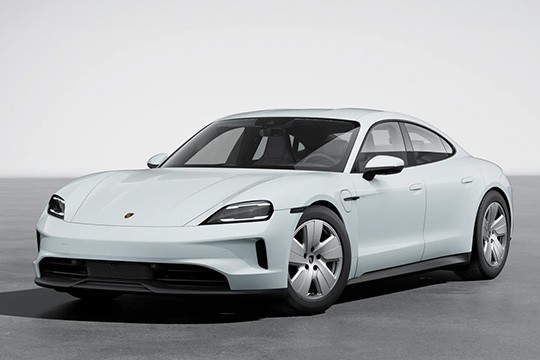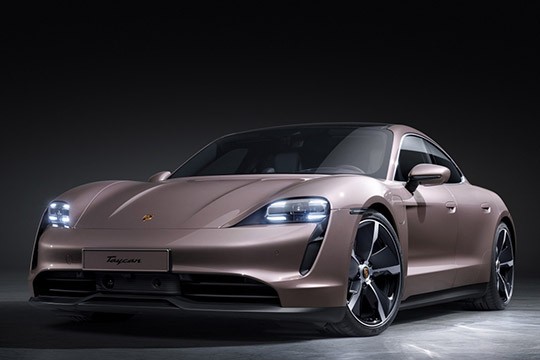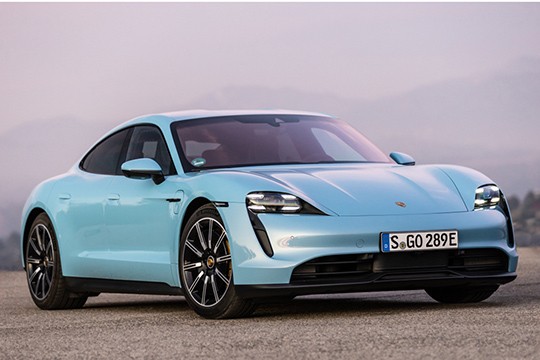PORSCHE Taycan Models/Series Timeline, Specifications & Photos
First production year: 2019
Engines: Electric
Porsche refreshed the Taycan lineup in 2024, five years after the car’s introduction, and the new facelifted version came with significant upgrades in all areas.
The Taycan was Porsche’s full-electric vehicle, and at the time of its launch, it stirred the market with its innovative technical solutions. Moreover, despite the problems encountered by most automakers, Porsche managed to sell more than 20,000 units in 2020 during the world pandemic situation. While the automaker initially offered the Taycan exclusively as a four-door sedan, it later added the Sports Tourismo (station wagon) and the Cross Tourismo (crossover) versions. The car was praised for its qualities and its 800-volt architecture that allowed it to charge at higher speeds than most other EVs on the market. With the 2024 model year, the facelifted Taycan lineup came with additional enhancements that made it more desirable.
At first sight, the facelifted Taycan didn’t look that much different than its predecessor, but it was. The car’s front underwent mild changes on the lower bumper, featuring a new design for the apron, with curved trims around the side air intakes. Porsche also upgraded the headlights, which it offered with standard Matrix LEDs. As an option, customers could get an HD Matrix technology system that further enhanced road illumination.
Porsche slightly upgraded the car’s side look with the redesigned standard 19-inch alloy wheels. As an option, customers could get a 20- or 21-inch set of wheels. The 2024 Taycan kept the same frameless windows for the doors, which were available with a soft-close function. Finally, at the back, the automaker installed OLED taillights extended from the quarter panels onto the trunk’s lid, while the lower diffuser was redesigned with additional vertical fins for better aerodynamics.
Inside, the automaker kept the same vegan upholstery for the entire range. At the front, customers were greeted by high-bolstered seats, which were available with a mix of Race-Tex microfiber outer sides. At the back, the automaker installed a bench seat profiled for two, like on the non-facelifted version. The most significant upgrade was for the infotainment system. Customers could install a Porsche dedicated app that allowed them to use the Apple CarPlay for more functions than before, including climate control settings. Unfortunately, the upgraded media system didn’t provide buttons for volume.
But the most significant upgrades were found under the car’s skin. The standard battery offered an 84 kWh net capacity, equivalent to the optional, large one from its predecessor. A 92 kWh battery was on the options list. Thanks to the 800-volt technology, the car could charge from 10% to 80% in 18 minutes with a peak power of 320 kW. The motors were also improved and provided better 0 to 62 mph (0-100 kph) time by up to 0.6 seconds for the base version. Porsche offered the Taycan with standard air suspension across the range. As an option, a Porsche Active Ride suspension was available. This system added a hydraulic compensation that kept the vehicle leveled during high-speed cornering, accelerations, or braking. Furthermore, it allowed the car to lean inside a curve to enhance passengers’ comfort.
Porsche refreshed in 2021 its first full-electric vehicle, the Taycan, and added more range and better features to the four-door sedan.
When the German sports cars maker announced the Taycan, its fans were in shock. But Porsche faced the cruel reality of climate change and the fines for CO2 emissions and had to do something. It didn’t start with the iconic 911 lineup but introduced a completely new model, the Taycan, in 2019.
Come 2021, and the carmaker updated the Taycan and showed it on the small exterior changes. The entire lineup featured standard LED headlights. A pair of vertical air-intakes flanked the front bumpers as on the non-facelifted version, but they were wider. At the back, depending on the version, it sported a new bumper and diffuser.
Inside, Porsche installed a partial-leather upholstery on the entire Taycan range. The carmaker pointed out that it was a man-made type and that it wouldn’t offer natural leather for the four-door sedan. A 10.9” display for the infotainment system found its place in the middle of the dashboard and offered another screen, as an option, in front of the passenger.
Porsche offered the 2021 Taycan with a choice of two battery packs, which provided a range of 407 km (253 miles) and 463 km (288 miles), respectively.
After Porsche stormed the market with the Taycan Turbo and the Turbo S, it unveiled a tamed, more affordable version of its first full-electric vehicle, the Taycan 4S.
Even though it wore badges carried over from the 911 lineup, it didn’t mean that it had an internal combustion engine under its hood. It was powered by electrons, and it was designed to stay like that forever, confirming Porsche’s commitment to the new EV era. But unlike its siblings, which were focused more on performance than on usability, the Taycan S tried to be more like a premium electric sports car with four doors and room for four adults inside. And even if it was slower and less performant than its siblings, it was no slouch.
This new base version of the Taycan had a similar-looking front fascia to its siblings. It featured the same headlights with four LED blocks for the daytime running lights and thin, vertical functional scoops underneath. Still, the lower bumper looked less aggressive than its siblings and featured two horizontal slats due to its black color instead of body-colored parts. In the middle, these were interrupted by the radar for the adaptive cruise control when fitted. From its profile, it looked more like a coupe than a four-door vehicle. Just like its siblings, it sported frameless windows. At the back, despite the sloped rear end that made the car look like a hatchback, its trunk lid opened without the windscreen.
Inside, the base model came with fewer enhancements than its Turbo and Turbo S siblings, but it wasn’t basic either. The base model came with part-leather upholstery and front eight-way adjustable seats. In addition, the 10.9 infotainment screen was included, but the second touchscreen placed in front of the passenger was on the options list. The sporty seats were comfortable and mounted low on the floor to ensure occupants a sportscar-like experience. In front of the driver, the automaker placed a digital instrument cluster with a design resembling the 911. In the back, Porsche installed three seat belts and three headrests, suggesting that it was big enough for three adults, but in reality, the legroom and headroom were limited. As a result, the Taycan 4S, just like its siblings, was good to transport five people, but only on short jaunts. But, as a surprise, those seated there had their own control panel for the HVAC system, which was placed on the center console’s ending. As an option, the automaker offered outboard heated seats for the rear passengers.
For the technical part, Porsche decided to provide the vehicle with a choice of a 79.2 kWh or a 93.4 kWh battery pack. The latter version was, obviously, heavier than the former one. To compensate the weight difference, the former version offered 530 PS (523 hp), while the latter boasted 571 PS (563 hp). Both variants used a twin motor setup, one for each axle. Unlike most electric cars on the market, the Taycan 4S featured a two-speed gearbox for the rear axle, which improved energy efficiency at higher speeds.


